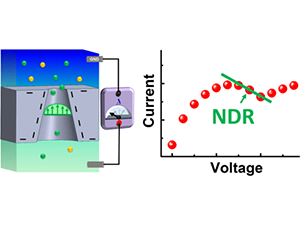Electrodiffusioosmosis-Induced Negative Differential Resistance in pH-Regulated Mesopores Containing Purely Monovalent Solutions

ACS Appl. Mater. Interfaces 2020, 12, 2, 3198-3204
Chih-Yuan Lin, Pei-Hsuan Wong, Pei-Hsin Wang, Zuzanna S. Siwy, and Li-Hsien Yeh
The abstract reads as follows: Negative differential resistance (NDR) refers to a unique electrical property where current decreases with increasing voltage. Herein, we report experimental evidence showing that the NDR effect can be observed in mesopores that feature charged pore walls and are subjected to a KCl concentration gradient. NDR in our system originates from the solution and ion flows driven by the synergistic effects of electroosmosis [electroosmotic flow (EOF)] and diffusioosmosis, the so-called electrodiffusioosmosis. Experiments reveal that in addition to the ion current rectification, the mesopores considered here exhibit the NDR phenomenon that is dependent on the magnitude and direction of the salinity gradient and on pH. The NDR behavior can be observed only at conditions at which the EOF and diffusioosmosis occur in the opposite directions: diffusioosmosis fills the tip opening with a high concentration solution, while EOF brings a low concentration solution to the pore. All experimental findings are supported by our numerical model, which takes into account the interfacial site reactions of acidic and basic functional groups on the entire pore membrane surfaces. Our results provide an important insight into how liquid pH, salinity gradients, interfacial site reactions, and pore geometries can influence the current–voltage characteristics of mesopores, enriching transport modes that can be induced by voltage.
C.-Y.L. and Z.S.S. acknowledge the funding supported by the U.S. Department of Energy, Office of Science, Basic Energy Sciences under award no. DESC0019112.
https://pubs.acs.org/doi/full/10.1021/acsami.9b18524
